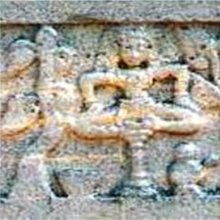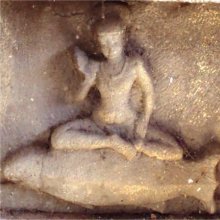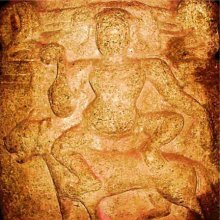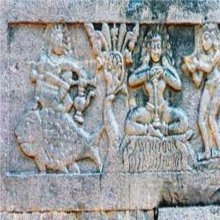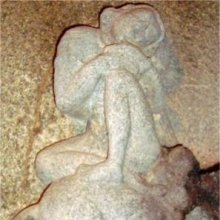Goraksha, Gorakṣa, Go-raksha: 21 definitions
Introduction:
Goraksha means something in Buddhism, Pali, Hinduism, Sanskrit, Marathi, biology. If you want to know the exact meaning, history, etymology or English translation of this term then check out the descriptions on this page. Add your comment or reference to a book if you want to contribute to this summary article.
The Sanskrit term Gorakṣa can be transliterated into English as Goraksa or Goraksha, using the IAST transliteration scheme (?).
Images (photo gallery)
In Hinduism
Shaivism (Shaiva philosophy)
Source: Wisdom Library: Śaivism1) Gorakṣa (गोरक्ष) is the disciple of Vikarāla: a teacher to whom the Kāpālika doctrine was revelead, mentioned in the Śābaratantra. The Śābara-tantra is an early tantra of the Kāpālika sect containing important information about the evolution of the Nātha sect. It also lists the twelve original Kāpālika teachers and their disciples (eg., Gorakṣa). Several of these names appear in the Nātha lists of eighty-four Siddhas and nine Nāthas.
2) Gorakṣa is the name of one of the eighteen Siddhars mentioned in the Abhidāna-cintāmaṇi, a 12th century lexicon by Hemacandra. The Siddhars refers to ancient intellectuals of Tamil Nadu and are the teachers of Siddha medicine: an ancient practice of South-India claiming to over 8,000 years old.
According to tradition, Nandi and Agastya learnt the Siddha system of medicine and Śivayoga from Śiva, and imparted it to a number of disciples (eg., Gorakṣa). These Siddhars are united by their philosophy, accepting the human body as the microcosm of the universe, and seeing the human evolution as the ultimate accomplishment of the regenerative power of the Universe.
Source: DSpace at Pondicherry: Siddha Cult in Tamilnadu (shaivism)Goraksha (गोरक्स्ह) literally means protector of herd. He has the distinction of founding the largest sect of yogins in India. The followers of Gorakṣa are popularly known as nāths, yogis (jogis), Gorakhnāthis and Kānphaṭas. They are very familiar for their large ear-rings, usually of bone, that give them the name ‘Split ears’ (Kānphaṭa).
Source: SOAS University of London: Protective Rites in the Netra TantraGorakṣā (गोरक्षा) refers to the “protection of cows”, according to the Netratantra of Kṣemarāja: a Śaiva text from the 9th century in which Śiva (Bhairava) teaches Pārvatī topics such as metaphysics, cosmology, and soteriology.—Accordingly, [verse 10.7cd-17ab, while describing the worship of Bhairavī and Bhairava]—“[...] One should always worship [in times of] peace and prosperity, to suppress sickness and vice, [which are] the root cause of wasting away, [and] for the protection of cows (gorakṣā—gobrahmaṇeṣu rakṣārthaṃ), Brahmins, and men. One meditates on [Bhairava] as having equal radiance to snow, jasmine, the moon, or pearls. [He is] as clear as the curved moon and similar to immovable quartz. [He is] clear like the burning of the end of time, resembles a flower on the sacred tree, appears red like innumerable suns or, rather, red like a lotus. [...]”.

Shaiva (शैव, śaiva) or Shaivism (śaivism) represents a tradition of Hinduism worshiping Shiva as the supreme being. Closely related to Shaktism, Shaiva literature includes a range of scriptures, including Tantras, while the root of this tradition may be traced back to the ancient Vedas.
Yoga (school of philosophy)
Source: Wisdom Library: YogaGorakṣa is one of the eighty-four Siddhas associated with eighty-four Yogic postures (āsanas), according to popular tradition in Jodhpur, Rājasthān. These posture-performing Siddhas are drawn from illustrative sources known as the Nava-nātha-caurāsī-siddha from Vȧrāṇasī and the Nava-nātha-caruāsī-siddha-bālāsundarī-yogamāyā from Puṇe. They bear some similarity between the eighty-four Siddhas painted on the walls of the sanctum of the temple in Mahāmandir.
The names of these Siddhas (e.g., Gorakṣa) to 19th-century inscription on a painting from Jodhpur, which is labelled as “Maharaja Mansing and eighty-four Yogis”. The association of Siddhas with yogis reveals the tradition of seeing Matsyendra and his disciple Gorakṣa as the founders of haṭhayoga.
Source: ORA: Amanaska (king of all yogas): A Critical Edition and Annotated Translation by Jason BirchGorakṣa (गोरक्ष) or Gorakṣanātha is the author of the Amaraughaprabodha: a short 13th century treatise on Yoga attributed to Gorakṣanātha which teaches the fourfold system of yoga (Mantra, Laya, Haṭha and Rāja).—Accordingly, “Gorakṣa, who abides constantly in the state of Samādhi, taught Mantra, Laya and Haṭhayoga for the sole purpose of attaining Rājayoga”.

Yoga is originally considered a branch of Hindu philosophy (astika), but both ancient and modern Yoga combine the physical, mental and spiritual. Yoga teaches various physical techniques also known as āsanas (postures), used for various purposes (eg., meditation, contemplation, relaxation).
Ayurveda (science of life)
Nighantu (Synonyms and Characteristics of Drugs and technical terms)
Source: WorldCat: Rāj nighaṇṭuGorakṣa (गोरक्ष) is another name for Ṛṣabhaka, a medicinal plant possibly identified with Microstylis muscifera Ridley which is a synonym of Malaxis muscifera (Lindl.) or “fly bearing malaxis” from the Orchidaceae or “orchid” family of flowering plants, according to verse 5.14-16 of the 13th-century Raj Nighantu or Rājanighaṇṭu. The fifth chapter (parpaṭādi-varga) of this book enumerates sixty varieties of smaller plants (kṣudra-kṣupa). Together with the names Gorakṣa and Ṛṣabhaka, there are a total of twenty Sanskrit synonyms identified for this plant.

Āyurveda (आयुर्वेद, ayurveda) is a branch of Indian science dealing with medicine, herbalism, taxology, anatomy, surgery, alchemy and related topics. Traditional practice of Āyurveda in ancient India dates back to at least the first millenium BC. Literature is commonly written in Sanskrit using various poetic metres.
In Buddhism
Tibetan Buddhism (Vajrayana or tantric Buddhism)
Source: Wisdomlib Libary: VajrayanaGorakṣa is the name of a mahāsiddha, of which eighty-four in total are recognized in Vajrayāna (tantric buddhism). His title is “the immortal wowherd”. He lived somewhere between the 8th and the 12th century AD.
These mahāsiddhas (e.g., Gorakṣa) are defined according to the Abhayadatta Sri (possibly Abhayākaragupta) tradition. Its textual origin traces to the 11th century caturāsiti-siddha-pravṛtti, or “the lives of the eighty-four siddhas”, of which only Tibetan translations remains. Mīnapa (and other Mahāsiddhas) are the ancient propounders of the textual tradition of tantric or Vajrayana Buddhism.
Source: Shodhganga: The Philosophy and Practice in Lakulisa Pasupata order (Buddhism)Goraksa is the name of a Buddhist Siddhacarya corresponding with Gorakhnath (according to the Natha philosophy) and with Goraksa teacher (according to Sabaratantra).—The interesting overlap between, Buddhist Siddhacaryas teachers of Kapalika sect and Nathas of Natha Sampradyay points at certain similarities between these highly esoteric cults. The fact that the same Siddha [e.g., Goraksa] is considered as a Natha and also as a Kapalika teacher talks of a common spiritual tradition followed by these great masters irrespective of the religion they followed or the religion with which they got associated. It throws light on the mutually exclusive nature of spiritual lineages and religion in India.

Tibetan Buddhism includes schools such as Nyingma, Kadampa, Kagyu and Gelug. Their primary canon of literature is divided in two broad categories: The Kangyur, which consists of Buddha’s words, and the Tengyur, which includes commentaries from various sources. Esotericism and tantra techniques (vajrayāna) are collected indepently.
Biology (plants and animals)
Source: Google Books: CRC World Dictionary (Regional names)Goraksa in India is the name of a plant defined with Dalbergia lanceolaria in various botanical sources. This page contains potential references in Ayurveda, modern medicine, and other folk traditions or local practices It has the synonym Dalbergia lanceolaria Moon.
Example references for further research on medicinal uses or toxicity (see latin names for full list):
· Revisio Generum Plantarum (1891)
· Supplementum Plantarum (1782)
· Cytologia (1989)
· Journal of Cytology and Genetics (1990)
· Journal of Ethnopharmacology (2007)
· The Civil and Natural History of Jamaica (1756)
If you are looking for specific details regarding Goraksa, for example diet and recipes, side effects, pregnancy safety, health benefits, chemical composition, extract dosage, have a look at these references.

This sections includes definitions from the five kingdoms of living things: Animals, Plants, Fungi, Protists and Monera. It will include both the official binomial nomenclature (scientific names usually in Latin) as well as regional spellings and variants.
Languages of India and abroad
Marathi-English dictionary
Source: DDSA: The Molesworth Marathi and English Dictionarygōrakṣa (गोरक्ष).—m S Popularly gōrakha or gōrakhanātha The name of the celebrated Hindu reformer.
--- OR ---
gōrakṣa (गोरक्ष) [or गोरक्षक, gōrakṣaka].—m (S) A cowherd. 2 The tutelar deity of cattle.
Source: DDSA: The Aryabhusan school dictionary, Marathi-Englishgōrakṣa (गोरक्ष).—m A cowherd. The tutelar deity of cattle.
Marathi is an Indo-European language having over 70 million native speakers people in (predominantly) Maharashtra India. Marathi, like many other Indo-Aryan languages, evolved from early forms of Prakrit, which itself is a subset of Sanskrit, one of the most ancient languages of the world.
Sanskrit dictionary
Source: DDSA: The practical Sanskrit-English dictionaryGorakṣa (गोरक्ष).—
1) a cowherd.
2) keeping or tending cattle.
3) the orange.
4) an epithet of Śiva. °जम्बू (jambū) f. wheat.
Derivable forms: gorakṣaḥ (गोरक्षः).
Gorakṣa is a Sanskrit compound consisting of the terms go and rakṣa (रक्ष).
Source: Cologne Digital Sanskrit Dictionaries: Shabda-Sagara Sanskrit-English DictionaryGorakṣa (गोरक्ष).—mfn.
(-kṣaḥ-kṣā-kṣaṃ) A cow keeper, the cherisher or preserver of kine. m.
(-kṣaḥ) 1. The orange. 2. Keeping or tending cattle. 3. A name of Siva. f. (-kṣī) A small shrub. E. go a cow, and rakṣa who preserves.
Source: Cologne Digital Sanskrit Dictionaries: Benfey Sanskrit-English DictionaryGorakṣa (गोरक्ष).—[go-rakṣa], and gorakṣya gorakṣya, i. e. gorakṣa + ya, n. Attendance on cattle, keeping cattle, [Mānavadharmaśāstra] 10, 8; 116.
--- OR ---
Gorakṣa (गोरक्ष).—I. m. a cowhered. Ii. n. keeping cattle, Mahābhārata 2, 525.
Gorakṣa is a Sanskrit compound consisting of the terms go and rakṣa (रक्ष).
Source: Cologne Digital Sanskrit Dictionaries: Cappeller Sanskrit-English DictionaryGorakṣā (गोरक्षा).—[feminine] ksya [neuter] keeping or breeding cattle.
Source: Cologne Digital Sanskrit Dictionaries: Aufrecht Catalogus Catalogorum1) Gorakṣa (गोरक्ष) as mentioned in Aufrecht’s Catalogus Catalogorum:—See Gorakṣanātha: Gorakṣasaṃhitā.
2) Gorakṣa (गोरक्ष):—See Maheśvarānanda.
Source: Cologne Digital Sanskrit Dictionaries: Monier-Williams Sanskrit-English Dictionary1) Gorakṣa (गोरक्ष):—[=go-rakṣa] [from go] mfn. idem, [Horace H. Wilson]
2) [v.s. ...] m. a cowherd, [cf. Lexicographers, esp. such as amarasiṃha, halāyudha, hemacandra, etc.]
3) [v.s. ...] a Gorkha or inhabitant of Nepāl, [Horace H. Wilson]
4) [v.s. ...] Śiva, [cf. Lexicographers, esp. such as amarasiṃha, halāyudha, hemacandra, etc.]
5) [v.s. ...] Name of an author (= kṣa-nātha)
6) [v.s. ...] the orange tree, [cf. Lexicographers, esp. such as amarasiṃha, halāyudha, hemacandra, etc.]
7) [v.s. ...] the medicinal plant Ṛṣabha, [cf. Lexicographers, esp. such as amarasiṃha, halāyudha, hemacandra, etc.]
8) [v.s. ...] n. = gorakṣā, for kṣya q.v., [Manu-smṛti x, 82; Mahābhārata ii, iii, xiii; Rāmāyaṇa ii]
9) Gorakṣā (गोरक्षा):—[=go-rakṣā] [from go-rakṣa > go] f. tending or breeding cattle, business of a herdsman, [Mahābhārata i] (ifc. f(ā). ), ii, [Harivaṃśa 363]
Source: Cologne Digital Sanskrit Dictionaries: Yates Sanskrit-English DictionaryGorakṣa (गोरक्ष):—[go-rakṣa] (kṣaḥ) 1. m. The orange; a cowkeeper; Shiva. (kṣī) f. A shrub.
[Sanskrit to German]
Sanskrit, also spelled संस्कृतम् (saṃskṛtam), is an ancient language of India commonly seen as the grandmother of the Indo-European language family (even English!). Closely allied with Prakrit and Pali, Sanskrit is more exhaustive in both grammar and terms and has the most extensive collection of literature in the world, greatly surpassing its sister-languages Greek and Latin.
Kannada-English dictionary
Source: Alar: Kannada-English corpusGōrakṣa (ಗೋರಕ್ಷ):—
1) [noun] one who tends and guards cows; a cowherd.
2) [noun] the plant Dregea volubilis ( = Marsdenia volubilis) of Asclepiadaceae family; cotton milk plant.
Kannada is a Dravidian language (as opposed to the Indo-European language family) mainly spoken in the southwestern region of India.
See also (Relevant definitions)
Starts with (+8): Gorakshacikitsa, Gorakshadasa, Gorakshadugdha, Gorakshadugdhi, Gorakshaganja, Gorakshajambu, Gorakshaka, Gorakshakalpa, Gorakshakarkati, Gorakshakhyana, Gorakshakritagrantha, Gorakshamuli, Gorakshana, Gorakshanatha, Gorakshaphalini, Gorakshapura, Gorakshasahasranaman, Gorakshasamhita, Gorakshasana, Gorakshashataka.
Ends with: Dattatreyagoraksha, Nivrittakrishigoraksha, Sadgoraksha.
Full-text (+164): Gorakshatandula, Gorakshajambu, Gorakshashataka, Sadgoraksha, Gorakshi, Gorakshasana, Gorakshakalpa, Gorakshadasa, Gorakshakarkati, Gorakshasahasranaman, Gorakshanatha, Gorakshadugdha, Gorakshatumbi, Gorakshapura, Gorakshamuli, Gorakshaka, Gorakshadugdhi, Gorakshe, Kharavallika, Gorakshya.
Relevant text
Search found 19 books and stories containing Goraksha, Gorakṣa, Go-raksha, Goraksa, Gōrakṣa, Go-rakṣa, Go-raksa, Gorakṣā, Go-rakṣā; (plurals include: Gorakshas, Gorakṣas, rakshas, Goraksas, Gōrakṣas, rakṣas, raksas, Gorakṣās, rakṣās). You can also click to the full overview containing English textual excerpts. Below are direct links for the most relevant articles:
Lakulisha-Pashupata (Philosophy and Practice) (by Geetika Kaw Kher)
Samkaracarya and Kapalikas < [Chapter 2 - Spread and Transition]
Goraksanatha and Natha Sampradaya < [Chapter 2 - Spread and Transition]
Srikantha in the Saiva pantheon < [Chapter 1 - The Historical Context]
The Garuda Purana (by Manmatha Nath Dutt)
Chapter CCIX - Various other Recipes < [Dhanvantari Samhita]
A History of Indian Philosophy Volume 5 (by Surendranath Dasgupta)
Part 1 - History and Literature of Vīra-śaivism < [Chapter XXXV - Vīra-śaivism]
Brihad Bhagavatamrita (commentary) (by Śrī Śrīmad Bhaktivedānta Nārāyana Gosvāmī Mahārāja)
Verse 2.1.112-112 < [Chapter 1 - Vairāgya (renunciation)]
Verse 1.6.73-75 < [Chapter 6 - Priyatama (the most beloved devotees)]
Jainism and Patanjali Yoga (Comparative Study) (by Deepak bagadia)
Part 3 - Various Scriptures of Yoga < [Chapter 2 - Yoga philosophy and practices]
Lalitopakhyana (Lalita Mahatmya) (by G.V. Tagare)
